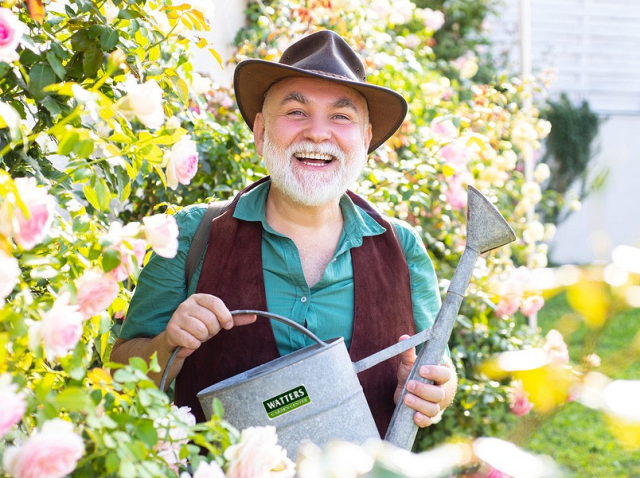by Ken Lain, the mountain gardener

How often to water is the most asked question at Watters Garden Center. Especially when starting a new flower bed or shallow-rooted vegetables.
For this garden column, the myths are dispelled, and the best time of day with general guidelines on frequency is explained.

Without a moisture meter, no one can tell you exactly how often to water, but you can get close. Elevation, sun exposure, soil type, humidity, in-ground, raised beds, and containers provide variables that change water frequency.
Good tools make gardening easier. Start with a good moisture meter. They are worth their weight in water and them some. Your grandparents used their sense of touch to feel the garden’s moisture.
Touching the Soil – Touch the Soil with your finger pressing it down a couple of inches to test. If it feels dry, it’s time to water; if it’s moist, give it another day or two and touch it again. The goal is to train plants to go as long as possible before irrigation, then water deeply. This conditions your plants to grow deeper roots and become more robust.
How to Water Flowers
The general rule for flowers is to water deeply when the soil is dry. Ideally, water flowers at the soil level, reducing the amount of water that sprays on their foliage. This reduces leaf spot and fungal issues during the rainy season.
Check the garden’s moisture before irrigating. Flowers like a rich soil that drains quickly. They need oxygen at their base to thrive. They do not like soggy soil and rot in the round when their roots are exposed to long to water.
Location and weather are the most significant determinants of how much water you should give your plants. The hotter seasons require more water as the soil dries out faster than cooler spring temperatures.
A dehydrated flower can be nursed back to life by putting it on a regular water schedule while testing the soil for moisture. Some flowers have a better drought tolerance due to the waxy surface, textured leaf, or fleshy roots allowing them to conserve more water than others. Zinnia, Geranium, Potato Vine, and Dahlia are excellent examples of drought-adaptive flowers that need water less often.
Sunburned Soil is when the sun bakes the garden soil until parched and cracks. This is the equivalent of a gardener’s skin turning lobster red from sunburn. A 2-3″ inch layer of Premium Mulch or Shredded Cedar Bark is like SPF 50 for plants that prevent soil from sunburn. This advice dramatically reduces your plant’s water need in the gardens.
AquaBoost Crystals are water-holding crystals holding 200 X their weight in water, encouraging plants to root deeper. Ideal for hot gardens, raised beds, and container gardens. Spring a few tablespoons under your flower roots, and they double the time between irrigation while cutting water use by 50%. Infused with 7 different Mycorrhizal Spores that encourage better root structure. If you have had problems with proper water, AquaBoost Crystals make gardening easier.
BIG Mistakes to Avoid
Overwater is one of the most common mistakes when starting new gardens. Signs of too much water are yellow leaves beginning at the bottom of the plant. Plants stop blooming and possibly shed fruits and flowers. Soaking roots for too long exposes them to asphyxiation from lack of oxygen. Parasitic gnats and fungal diseases begin to form.
Underwater is most dangerous with summer planting when the soil is bone dry. Never plant a dry plant in dry soil. Start by watering your plants before digging in the garden. When the garden soil is noticeably dry, try hydrating the planting hole before planting new flowers. Flowers grown in containers or raised beds should receive water until it seeps from the bottom of the pot.
Ideal Time to Water Flowers
Hydrated flowers go through the heat of the day healthier. Plants prefer dry foliage as the sun sets. The best time to water flowers is before eight in the morning through the growing season. Avoid night watering except for the hottest desert locations. This also reduces parasitic gnats and fungal diseases from forming.
Water Myth Debunked – Avoid noontime water because it could sunburn leaves. This is not true! In all my years, I’ve not witnessed sunburned leaves because of water. When the morning irrigation is missed, and plants are wilting midday, go ahead and help them.
How Long Can Flowers Go?
Again, exacts are not possible due to the factors affecting water schedules. As a rule, flowers should not be allowed to wilt or the soil to become bone dry.
During the bright days of Spring and Autumn, the nights are cool, so flowers should be able to go 3-4 days before needing hydration. In the heat of summer, before the rains arrive, flowers may need morning water daily. Winter water is necessary for perennial flowers every 7-14 days to keep them happy.
Until next week, I’ll be helping gardeners water better gardens here at Watters Garden Center.
Ken Lain can be found throughout the week at Watters Garden Center, 1815 Iron Springs Rd in Prescott, or contacted through his website at WattersGardenCenter.com or Top10Flowers.com.

